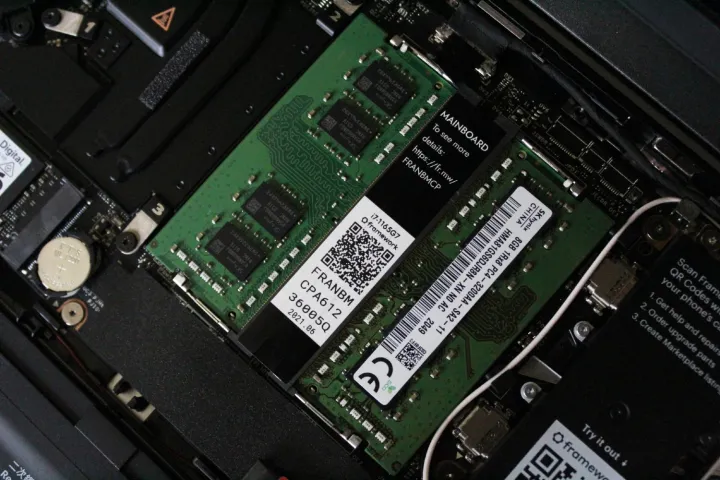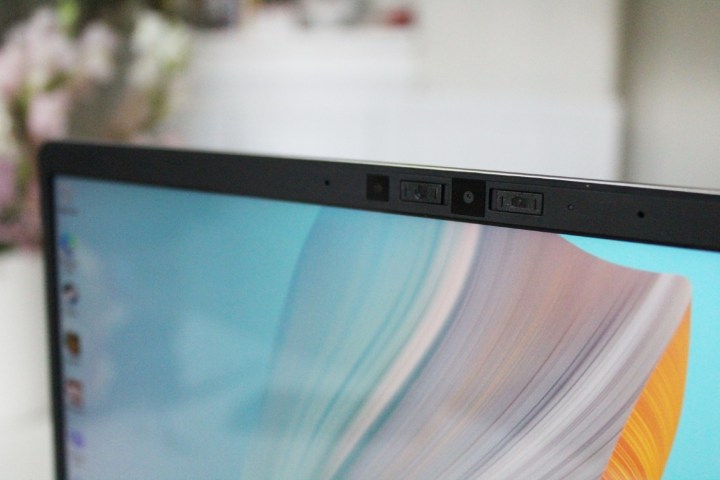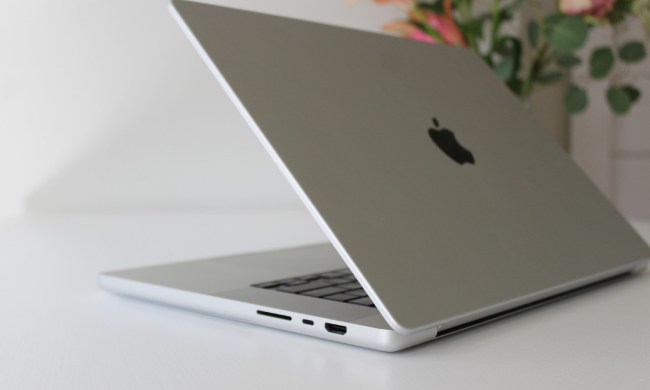“The Framework Laptop is more than just worthwhile experiment in modularity, it's also a great laptop.”
- Unbeatable upgradability
- Bright, high-resolution screen
- 1080p webcam
- Lots of key travel
- Easily exchangeable ports
- Runs hot
- Mediocre battery life
Even the very best laptops are only meant to last four or five years. Warranties expire, components get outdated, damage occurs, and not much of it is repairable.
That’s where the Framework Laptop disrupts the norm. It comes with a screwdriver included in the box, and customizing, updating, and repairing of all kinds is highly encouraged. A piece of technology that doesn’t run out of steam in a couple of product cycles? Now, there’s a novel idea.
For a starting price of $999, you get a premium, Windows laptop that looks and functions like any other. But the Framework philosophy is really what you’re paying for — and it’s what makes the Framework Laptop unlike any I’ve ever used.
Design

On the surface, the Framework Laptop is as ordinary a laptop as they come. It’s a basic silver laptop that resembles a cheaper version of a MacBook — not unlike countless Windows laptops and Chromebooks.
That’s not exactly a compliment, but maybe blending in is part of the point. The idea of the Framework Laptop looking and functioning like any other laptop feels important — especially if it’s trying to demonstrate how easy it would be for other laptops to take a similar approach to modularity. That doesn’t mean I wouldn’t have appreciated a more original design, of course.
Most laptop manufacturers claim that reduced upgradability is a necessary trade-off for portability, build quality, and system integrity. That’s true whether we’re talking about Apple with its MacBooks or Dell with its XPS 13.
But for the most part, the Framework Laptop proves those to be mere excuses. It’s 0.62 inches thick and 2.9 pounds — not at all a chunky laptop. No, it’s not as small as the XPS 13 or Surface Laptop 4, but it’s very close to the same size as the MacBook Pro 13-inch. Laptops like the Razer Blade Stealth 13 or Asus ROG Flex X13 have pushed the performance limits of 13-inch laptops, stuffing discrete graphics cards into similar physical dimensions.

Build quality is the one major area where the Framework Laptop has to make a sacrifice. It’s not that it’s poorly built, but it’s certainly not made from a single block of machined aluminum either. Because the keyboard cover, bezels, and ports can all be removed, they each introduce extra panels that can potentially weaken the overall integrity of the structure. The lid has some bend to it, as does the keyboard deck and hinge. I also noticed a click sound that sometimes occurs when quickly opening and closing the laptop to its full 180 degrees.
But again, these are not things unheard of in a laptop at this price. It’s a miss in many midrange or premium laptops that can’t seem to get perfect. Framework Laptop fits into that category too, except that it has some legitimate reasons for its slightly less premium build quality.
Do I wish I could ditch these plastic bezels? Absolutely. With a glossy screen like this one, the option for just the glass bezels would have been great.
Ports and expandability
Ports are the simplest way the Framework Laptop’s modularity provides benefits. When you pull the Framework Laptop out of the box, it looks a bit strange, with its four exposed Thunderbolt 4 USB-C ports, two on either side of the laptop.
Framework allows you then to choose whatever ports you want. You’ll want at least one USB-C port for charging, but from there, it’s up to you. Maybe you want HDMI or even full DisplayPort for your monitor connections. Maybe you want three USB-A ports for all your accessories and peripherals. Or maybe you just want to toss all these “Expansion Cards” into a bag and use them as adapters for when the needs arise.
It’s the kind of thing gadget-heads will love. But it’s more than just a novelty. It also makes for a fairly versatile setup that no other laptop can replicate without the use of dongles, adapters, or hubs. Swapping out Expansion Cards is just as easy as plugging in a dongle and can be done without powering the system down.
I was let down when I saw that a full-sized SD card slot was not included as an Expansion Card. Framework instead went with a micro-SD slot, which is far less useful. But if Framework’s plans unfold as stated, many more options could be sold or included in the future.
But ports are only the first step. The entire system is built around the idea of easy access to the internal components. Most laptops offer access through a removable bottom lid, but the Framework Laptop provides entry from the top, right through the keyboard. Using the included screwdriver, just loosen the five fasteners on the bottom and pull the magnetic Input Cover off.

From there, you’ll see the internal layout, which is all neatly labeled and removable. Framework even went to the extent of including scannable QR codes that will tell you exactly what parts have been included and how to install them. It’s a true breath of fresh air. Laptop manufacturers tend to downplay the specific memory, storage, and connectivity being used — and would rather you didn’t dabble in tinkering. That’s not to say it’s completely unheard of today. Many gaming laptops still allow you to add memory or storage. But in thin-and-light laptops of this size, it’s becoming increasingly rare.
Removing components on the Framework Laptop couldn’t be simpler. Adding through the M.2 slot requires just loosening the fastener, while RAM snaps in with ease. The Wi-Fi module is a little trickier, which requires you to correctly connect the antennas cables. I love that all the screws are merely fasteners, ensuring that you never lose an important screw. Framework has thought through the smallest details, and it all adds up to an enjoyable upgrading experience, both for newbies and PC veterans.
Adding storage or RAM is a good way to extend the life of a laptop, but eventually, the processor and graphics will hold you up. That’s what makes the Framework Laptop even more special.

It should be noted that while the storage and RAM play nice with third-party parts that you buy and install yourself, the CPU and motherboard will need to be provided by Framework. That is, for now. The CPU and motherboard (or the Mainboard, as Framework calls it) are proprietary designs that can’t easily be separated on your own.
Framework also sells a discounted DIY Edition, which requires installing these modules yourself. For most people who are interested in the modularity of the Framework Laptop, the DIY Edition is a cheaper way of getting the exact same laptop experience.
Keyboard and touchpad

Coming into this review, I was concerned about the keyboard touchpad. They are the type of details that can get easily overlooked in a laptop more focused on user upgradability. I was pleasantly surprised by just how good these inputs are.
The keyboard has 1.5mm of travel, which felt heavenly under my fingers. If you’ve grown tired of the direction of shallower laptop keyboards, the Framework Laptop will provide rest for your weary fingers. This is one of the most comfortable laptop keyboards I’ve ever used. The layout is familiar, and there’s nothing that requires a learning curve.
This is one of the most comfortable laptop keyboards I’ve ever used.
The backlighting is bright and consistent, with three levels of brightness control. That’s become the standard for brightness control, but laptops like the Razer Blade or MacBook Pro offer more granular controls.
The touchpad isn’t quite as good as the keyboard, but it comes close. It’s large and responsive, tracking feels precise, and the click isn’t overly loud. Palm rejection is decent too, though there were a couple of times when the cursor would skip or move while typing.

Framework also includes a fingerprint reader at the top of the keyboard deck, built into the power button. It looks a little out of place and off-brand, but the fingerprint reader worked well for Windows Hello authentication.
Unfortunately, the Framework Laptop doesn’t include an IR camera for facial recognition, so you’ll have to depend on the fingerprint reader for passwordless logins.
Display

It would have been easy to go with an older, less forward-thinking display option on the Framework Laptop. Instead, it’s another aspect of the device that doesn’t just do the basics to get by. It features a 2560 x 1403 resolution in 3:2 aspect ratio, an increasingly popular alternative to 16:9. It means more vertical screen real estate and more room to get work done and display web pages.
It’s very similar in shape and size to the Surface Laptop 4, which also features a 3:2 13.5-inch screen. It doesn’t include a touchscreen in any of the configurations, but I adore this size of the laptop. It nails the balance between portability and screen size, giving you a comfortable space to work in without having to lug around a larger 15-inch laptop. The increased resolution and size are a dream if you’re coming from a 16:9 1080p laptop.
It’s a very bright screen, maxing out at 463 nits.
The image quality of the display isn’t the best I’ve seen, but it excels in a couple of key areas. First, it’s a very bright screen. It maxes out at 463 nits, which is a wealth of brightness that makes it a versatile laptop for working outside, near windows, or under bright fluorescent overhead lights. It’s also a high-contrast screen, with a max of 1090:1 at 100% screen brightness. The result is sharp text while reading or typing and dynamic lighting in videos and movies.
The colors are the weakest aspect of the screen. 76% of the AdobeRGB color space is by no means bad, but it’s a bit behind some of the leaders in the space such as the MacBook Pro, Samsung Galaxy Book Pro, and Razer Blade 14.
The color accuracy is also a bit off. My Spyder5 colorimeter produced some inconsistent results when reporting average color error, despite many tests. Framework says it uses the default calibration done by the panel maker, and in anecdotal use, colors felt fairly lifelike and natural. However, it might not be the best option for a professional color grader unless you plan on calibrating it yourself.
Webcam and speakers

The speakers are located along the bottom edge of the laptop, pointing down. The 3:2 aspect ratio of the screen doesn’t allow for as much width next to the keyboard for upward-firing speakers as I’d prefer. Considering the placement, these aren’t a bad set of speakers. They’re pitiful compared to the MacBook Pro 13-inch, of course, but the stereo separation sounds full, and the speakers don’t crackle at high volume.
Performance
The Framework Laptop is broken down into three simple configurations, scaling up processor performance, memory, and storage. It’s a straightforward way to sell a laptop, but it’s a little misleading, and the lack of configurations makes buying the Framework Laptop right off-page a bit limited. Then again, unlike most other laptops of this type, it wouldn’t be difficult to do something like buy the base configuration and add storage or RAM as you need it. That’s the beauty of user upgradability.
My review unit was the middle option, which comes with an Intel Core i7-1165G7, 16GB of RAM, and a 512GB SSD. While the $999 base configuration is fairly affordable, Framework charges quite a lot for the extra memory and storage. Dell charges just $100 to upgrade the XPS 13 from 8GB to 16GB, while Apple charges $200 for the same upgrade on the MacBook Pro. Microsoft is a notorious offender in this regard, charging $1,700 for an identical configuration to my $1,399 review configuration of the Framework Laptop. So, you’ll certainly save some money by upgrading yourself, even though $1,399 isn’t a horrible price for what the Framework Laptop offers.
Furthermore, the Framework Laptop performs admirably. I tested it in our suite of benchmarks, including Geekbench 5, Cinebench R23, PCMark 10, and 3DMark Time Spy.
| Geekbench 5 (single/multi) | Handbrake (seconds) | Cinebench R23 (single/multi) | PCMark 10 | 3DMark Time Spy | |
| Framework Laptop (Core i7-1165G7) |
1432 / 4725 | 176 | 1444 / 5373 | 5054 | 1641 |
| Dell XPS 13 (Core i7-1165G7) | 1540 / 5432 | 201 | 1399/4585 | 3859 | 1589 |
| HP Spectre x360 14 (Core i7-1165G7) | 1214 / 4117 | 236 | 1389 / 3941 | 4728 | 1457 |
| Samsung Galaxy Pro 360 (Core i7-1165G7) |
1554 / 5603 | N/A | 1308 / 4062 | 5159 | 1800 |
| Razer Book 13 (Core i7-1165G7) | 1548 / 5374 | 210 | 1508 / 4519 | 4878 | 1776 |
The Framework Laptop trades blows with some of the more powerful 13-inch Windows laptops you can buy, including the Razer Book 13 and Dell XPS 13. The strong multi-core performance in Cinebench R23 was worthy of note, beating every other competitor listed above. That great multi-core performance also translated well to fast video encoding times in Handbrake.
The Iris Xe graphics didn’t knock my socks off in the Time Spy benchmark, though, nor did it in any of the games I tested. It’s not a laptop that’ll be much of use in AAA PC gaming.
The thermals gave me some worry too. The CPU peaked at 100 degrees Celsius numerous times in runs of PCMark 10 and sustained temperatures in the very high 90s throughout the PCMark Spreadsheets test. The Ryzen CPU in the Asus ROG Flow X13, for example, stayed around 10 degrees cooler throughout this same benchmark, which is still running pretty hot. That’s not great. If you’re doing something particularly tasking, both surface and internal temperatures can get uncomfortably hot.
It handles video conferencing well, though, the fans never spinning up loud enough to interfere with the built-in microphones and speakers. The other good news is that even at high temperatures, the CPU was still humming along at around 4.4GHz.
Under heavy load, both surface and internal temperatures can get uncomfortably hot.
So, what’s the explanation for these kinds of temperatures? Well, open and accessible components certainly may be one of the culprits. Multiple fans, more heat pipes, large heatsinks, extra vents in the chassis, and other kinds of heat spreaders are all additional techniques laptops use to cool these components. The Framework Laptop is limited to just a single large fan, a couple of heat pipes, and some small openings along the bottom of the laptop for airflow. It’s certainly the weakest aspect of the Framework Laptop and one that could put some wear and tear on the internal components over time.
When asked, Framework affirmed that the system is designed to run at maximum boost frequency while staying within safe temperature restrictions. 100 degrees Celsius is technically the max temperature of the processor, but you don’t typically want to see your system running at such high temperatures. It’s not unheard of in competing laptops like the XPS 13, but it’s never a good thing to see.
Battery life

The Framework Laptop includes a 55 watt-hour battery, which is a decent-sized brick for a laptop of this size. However, higher-resolution screens like this one drain batteries faster, and the result is mediocre battery life performance.
The Framework Laptop lasted 7 hours and 11 minutes in a light web browsing test, which cycles through some heavier websites until the battery dies. Most laptops in this price range and category last longer in this test. The Dell XPS 13 lasts just under 8 and a half hours, while battery life champions like the Surface Laptop 4 last as much as 13 and a half hours. Even the Razer Book 13, which I dinged for its mediocre battery life, lasted a full hour longer than the Framework Laptop.
I also tested the laptop’s battery in local video playback, which loops a 1080p video clip until the battery runs out. The Framework Laptop died after 7 hours and 20 minutes. Again, this is quite a bit behind the competition.
The Framework Laptop won’t make you through a full day of work on a single charge, especially if your typical workload involves some tasking applications, lots of streaming, or heavier multitasking.
Our take
The Framework Laptop has a gimmick. Its modularity and upgradability are certainly its selling primary selling points, and if that’s not something you care about, look elsewhere. But unlike a lot of other experimental tech products, the Framework Laptop is also a great laptop. It’s not perfect, but the Framework Laptop doesn’t make you sacrifice much to enjoy its unique design.
Are there any alternatives?
In terms of upgradability, Framework Laptop doesn’t have many competitors. There are some larger laptops that still allow you to upgrade storage yourself, but not many in this size.
Price-wise, the Framework Laptop lands among premium laptops like the Dell XPS 13, MacBook Pro 13, and HP Spectre x360 14. The option of the DIY Edition, though, really helps make the Framework Laptop more affordable. Any number of other flagship laptops have strengths over the Framework Laptop, but none feature this amount of upgradability.
How long will it last?
Theoretically, as long as you want. Because almost all of the internal components are replaceable, a busted battery or outdated CPU doesn’t mean the whole laptop needs to be thrown out. I say theoretically, only because Framework has to hold up its end of the deal to really make it work.
In order to make this laptop last upwards of 10 or 15 years, it requires Framework to release new “Mainboards” with updated processors, which it has plans to do. The company has grand ambitions to even open up a third-party marketplace where aftermarket manufactures can get involved. None of that has launched yet, though. The interest in a store all built around the Framework Laptop will likely depend highly on the success and reception of the initial rounds of product releases.
Should you buy it?
Yes. If the idea of a long-lasting, user-upgradable laptop sounds even remotely appealing, the Framework Laptop is a dream come true.






